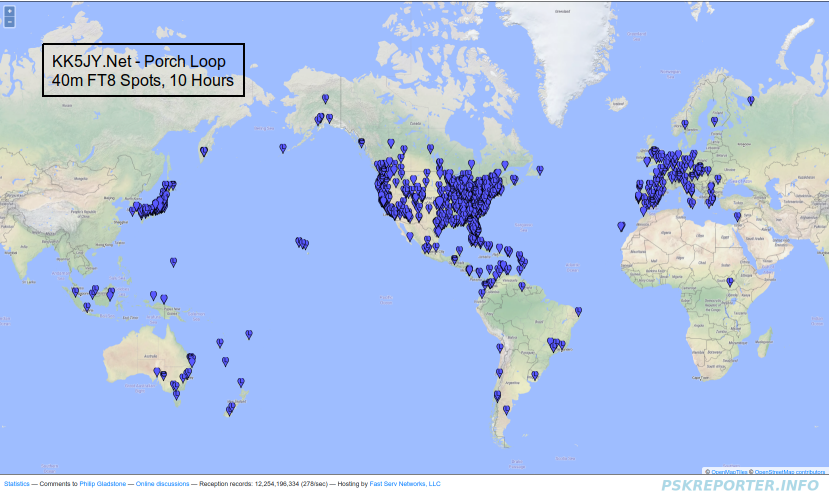
The Porch Loop
Matt Roberts - matt-at-kk5jy-dot-net
Published: 2020-05-05
Updated: 2022-06-19

Figure 1: Can you spot the loop?

Figure 2: Antenna Location

Figure 3: Feedpoint Transformer

Figure 4: 40m Reception
10h Overnight
The small receiving loop, or SRL, is a versatile, effective,
and space-efficient antenna, optimized for reception on the MF and HF bands.
They are easy to construct from common, inexpensive hardware components and
materials. Typical designs use symmetric shapes, like circles, diamonds,
octagons, etc., and are mounted on some kind of mast. This makes it
easy(-ier) to install the antenna clear of nearby metal and electronics. It
also makes the antenna rotatable, so that the broadside nulls can be pointed at RFI
sources.
These aren't the only options for the SRL, however. These little loops can be
made to fit in just about any available space. In fact:
- They are effective at any reasonable installation height, including
very close to the ground. The installation height doesn't change the
pattern shape, only the pattern strength.
- They can be made nearly any shape. The shape does not have to be
symmetric about any axis.
- They can be fed at just about any point on the loop. A typical feed
location is bottom-center, but off-center feeding has negligible effect on
the pattern shape.
- The wire can be bent out-of-plane; in other words, the loop doesn't have to be
"flat."
There are a couple of requirements for obtaining predictable performance,
however. First, the antenna does need to be an electrical loop.
That is, it is a single wire connected between the conductors of the feedline, forming
a complete circuit. Also, the circumference of the loop wire should be electrically
small (i.e., significantly less than λ / 4) on the bands where it is to be
used.
As a personal challenge, I recently installed such a loop on my front porch.
Everything about this installation defies conventional wisdom — it was installed
very close to the ground, it was an irregular shape, it was fed off-center, and the
wire was wound in and around an irregular support structure, rather than having all
the wire in a single plane.
And the resulting antenna still performed very well.
The loop is essentially the same device as the one in the
original SRL article. See that article for more construction
details. This version is simply stretched and twisted to make it fit the space and
supports available. The wire was woven around the boards in the porch's deck rail,
and fed near a lower corner, so that the transformer housing could be "hidden"
behind trash cans. The wire was insulated with an off-white
THHN,
which made it blend in with the color of the trim of the house.
Even with its suboptimal installation details, the overnight 40m DX spots were numerous
and well-distributed, as seen in Figure 4. There were DX spots at nearly
10,000 miles, there were NVIS spots, and there were countless at all distances in
between. So the oddly shaped antenna was just as effective as its more ideally
shaped brethren.
The strange shape and location can be helpful if one wants a larger loop than
is practical on a single mast. The loop shown at right measures 126" wide
by 30" tall, enclosing roughly four times the area of the mast-mounted SRL
described in the article linked above. This extra area allows the antenna to
capture more signal strength for the receiver, which can be especially helpful on the
longer wavelengths.
I use the porch loop regularly on 160m, where it has an impressive amount of signal
output for its size, with circumference just over 5% of the wavelength at 1840kHz.
Placing such an enlarged loop in an unusual location could be an easy way to improve
SNR for for MF and LF bands.
Other possibilities for creative loop installation locations might include:
- In an attic. The antenna could be nailed to a vertical panel, or strung
like a spider's web inside the frame of a truss or other open area.
- Under a tree. Taking another idea from the spiders, the antenna could be
hung and pulled into shape using light guys or tree branches.
- On a wooden fence. The antenna could be installed against the fence panels
of a wooden privacy fence. This option could allow a wide range of circumference
lengths.
- Around the perimeter of wooden deck railing, similar to the porch fence shown
at right. An elevated deck rail could provide even more loop area.
- Attached to an interior wall of an apartment. The shape could be chosen
to keep the loop clear of in-wall wiring, to help preserve its performance.
As with all receiving antennas, if the installation location places receiving and
transmitting antennas close to each other, it may be desirable to use a simple
receiver protection device to keep high-power
RF out of the receiver and any preamplifiers used.
The mast-mounted SRL antennas do have some advantages over
other receiving antennas. Perhaps the biggest advantage is that they can be easily
rotated to null out a nearby strong noise source. That said, if you are looking for
an antenna with better receive performance than a large resonant vertical, the SRL can
be stretched and squeezed into service just about anywhere.
Copyright (C) 2020-2022 by Matt Roberts, All Rights Reserved.








